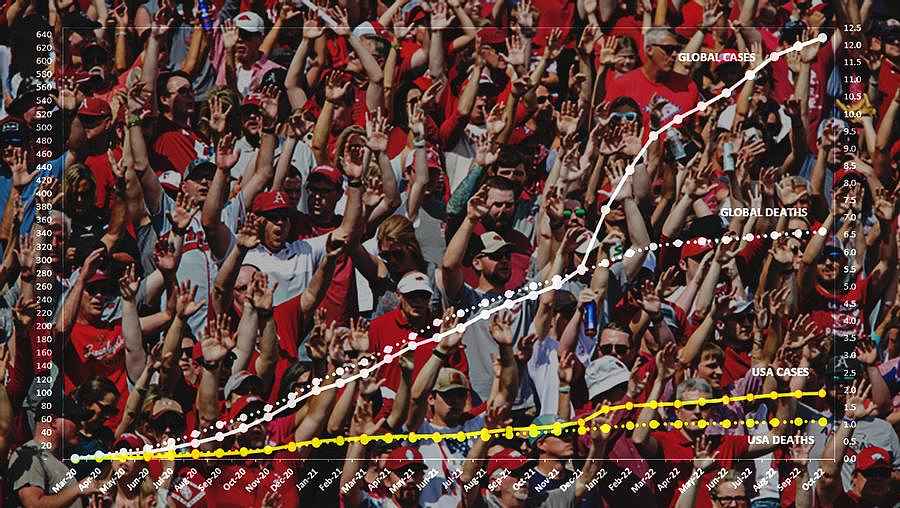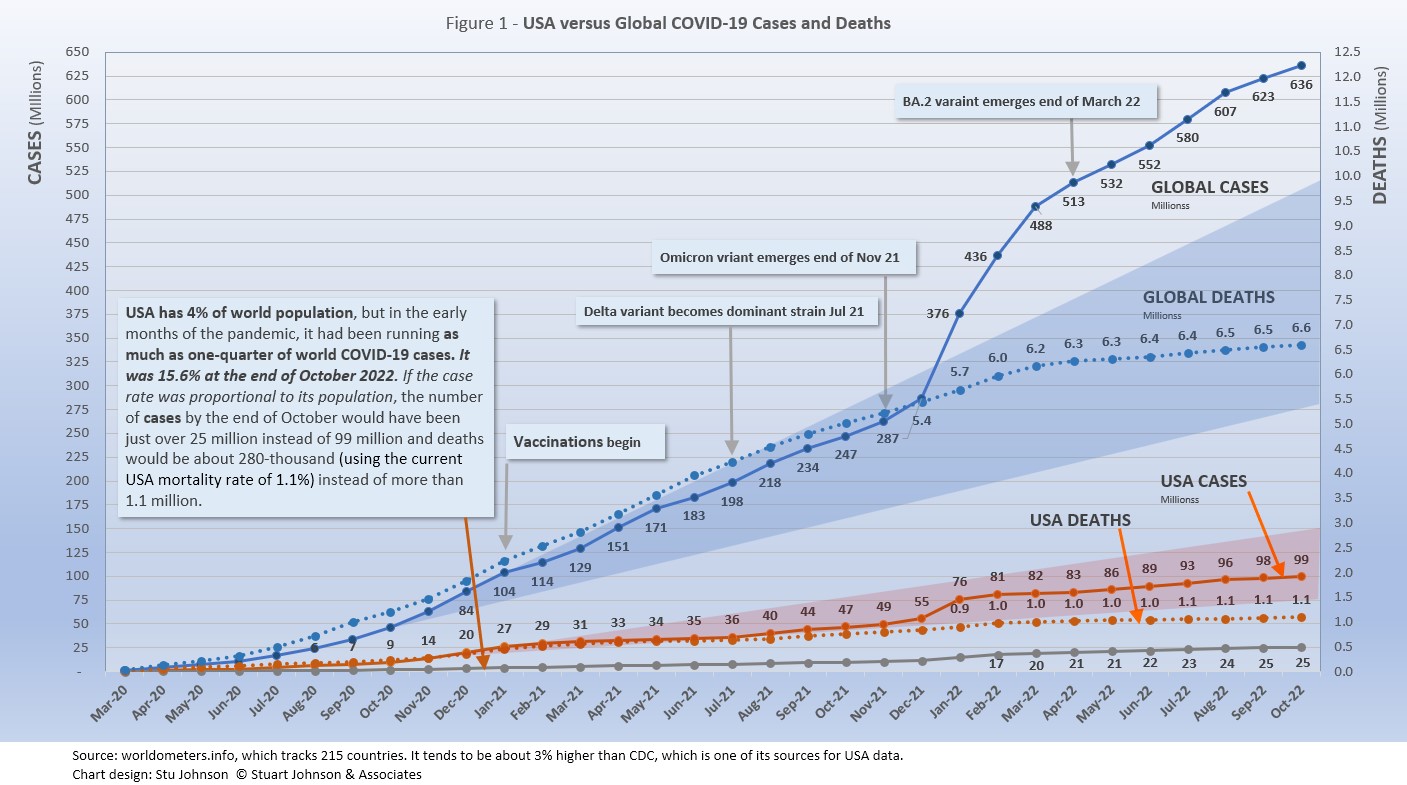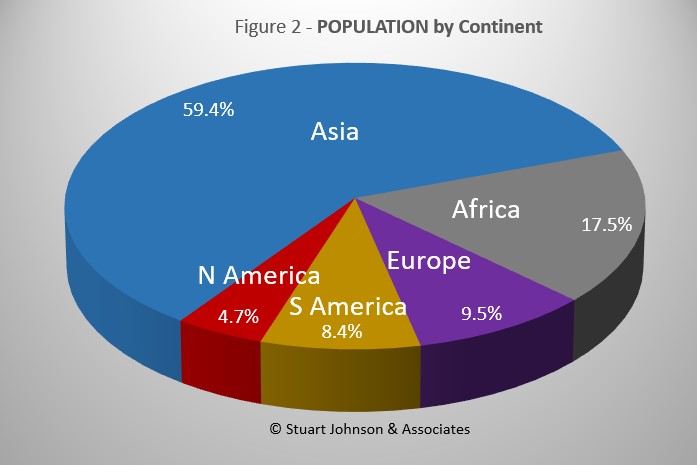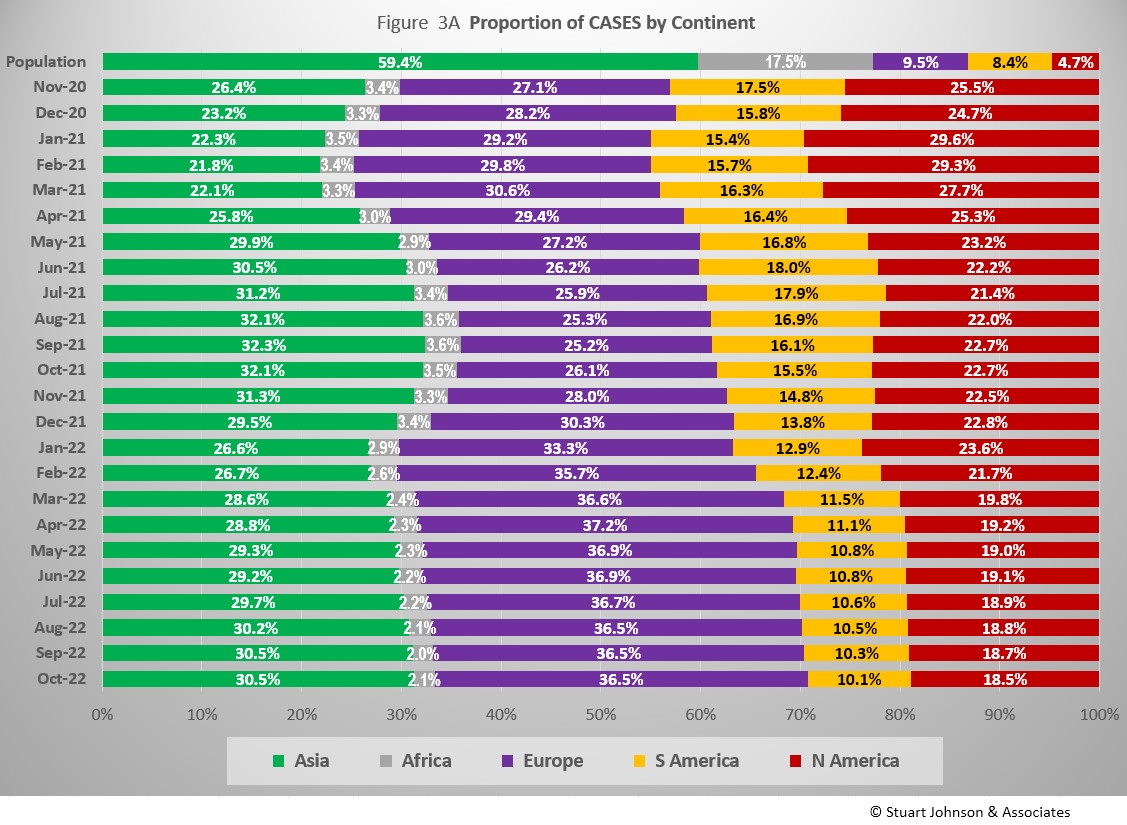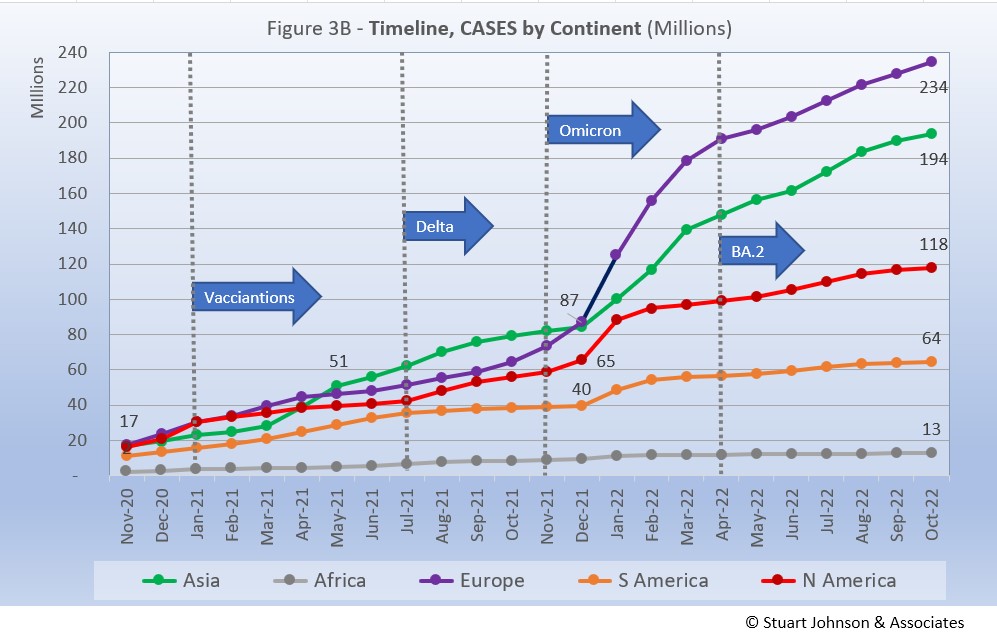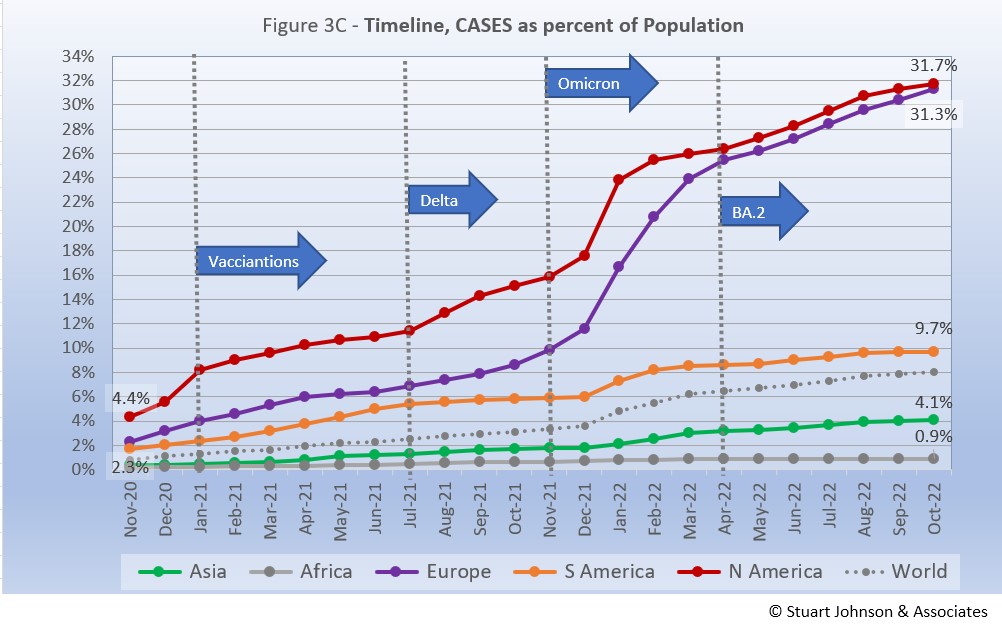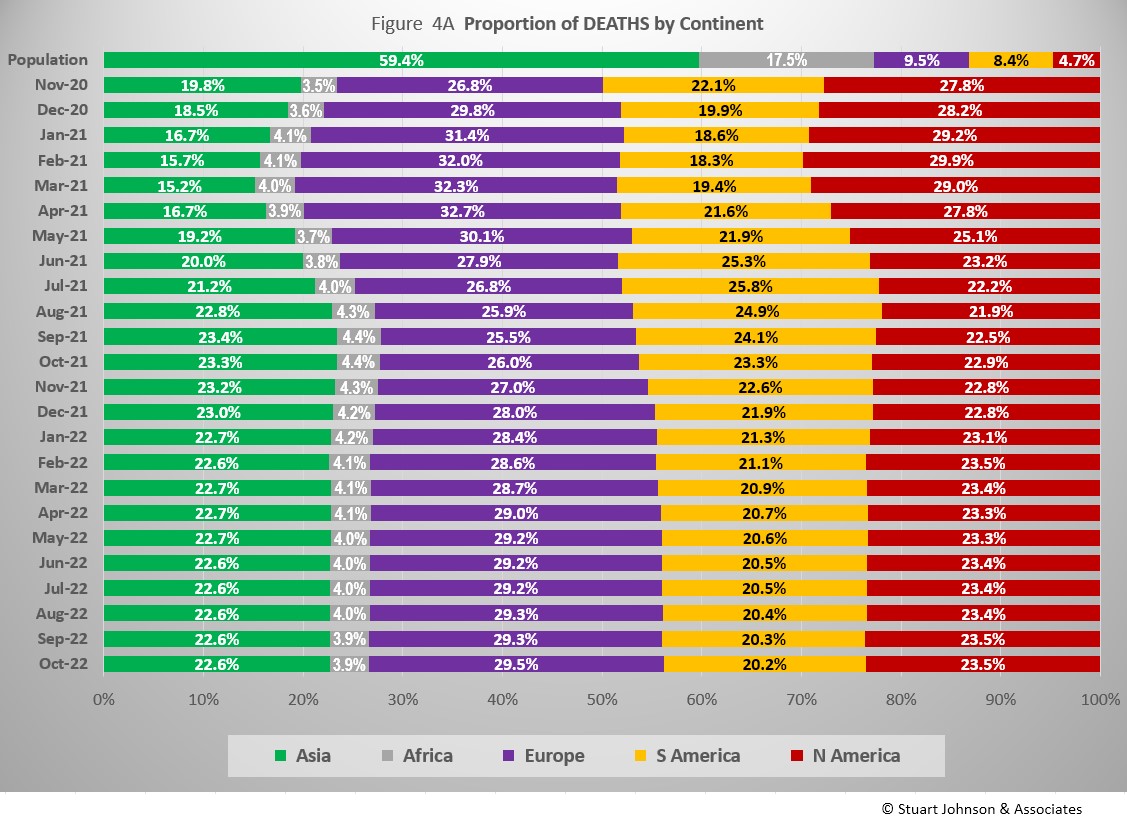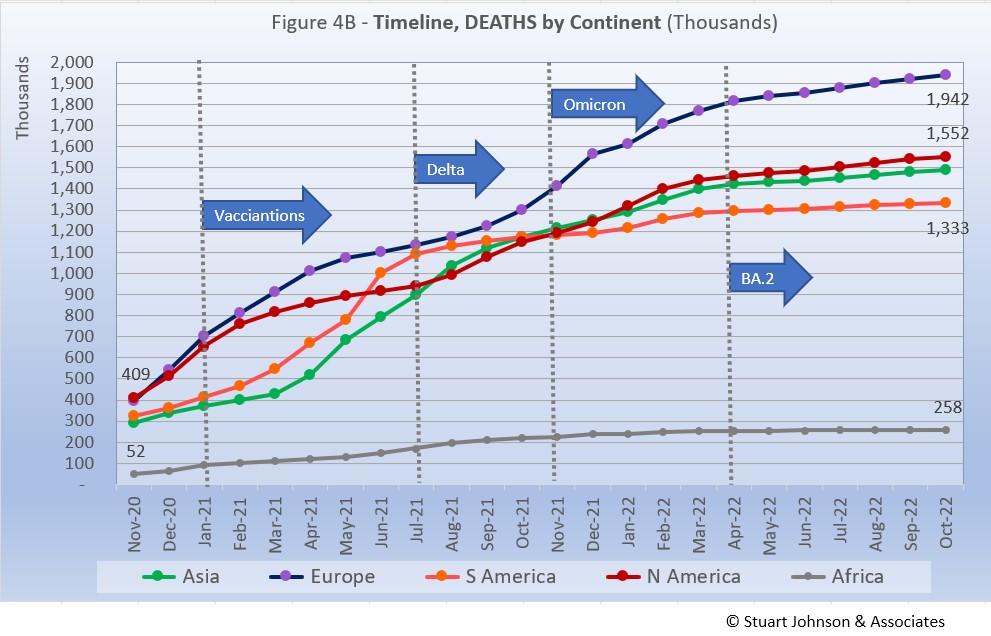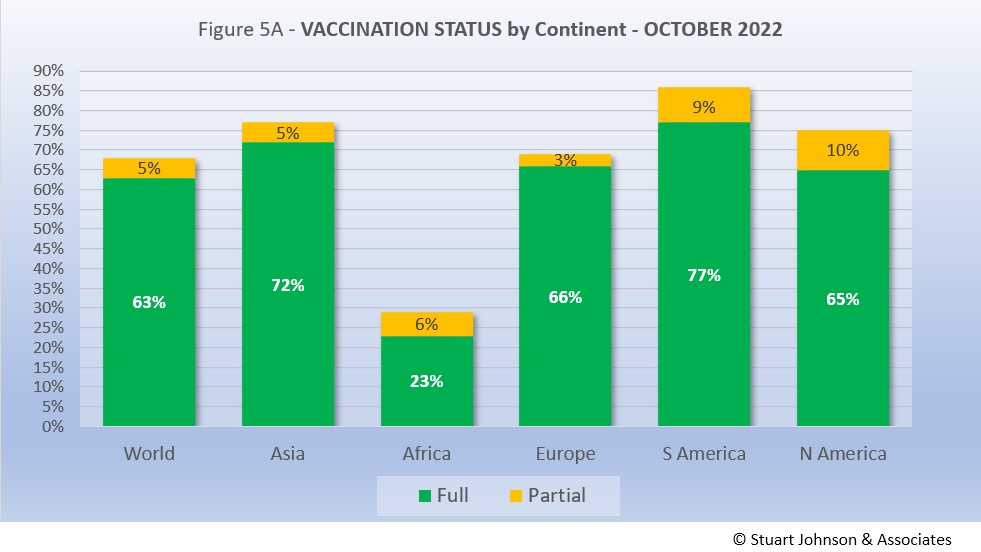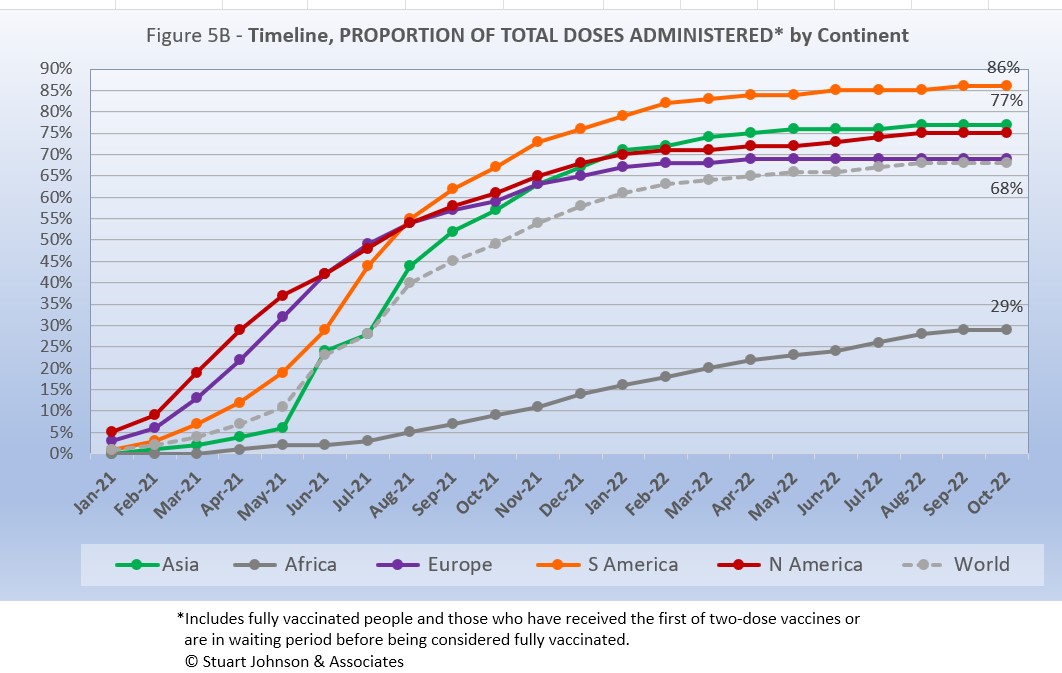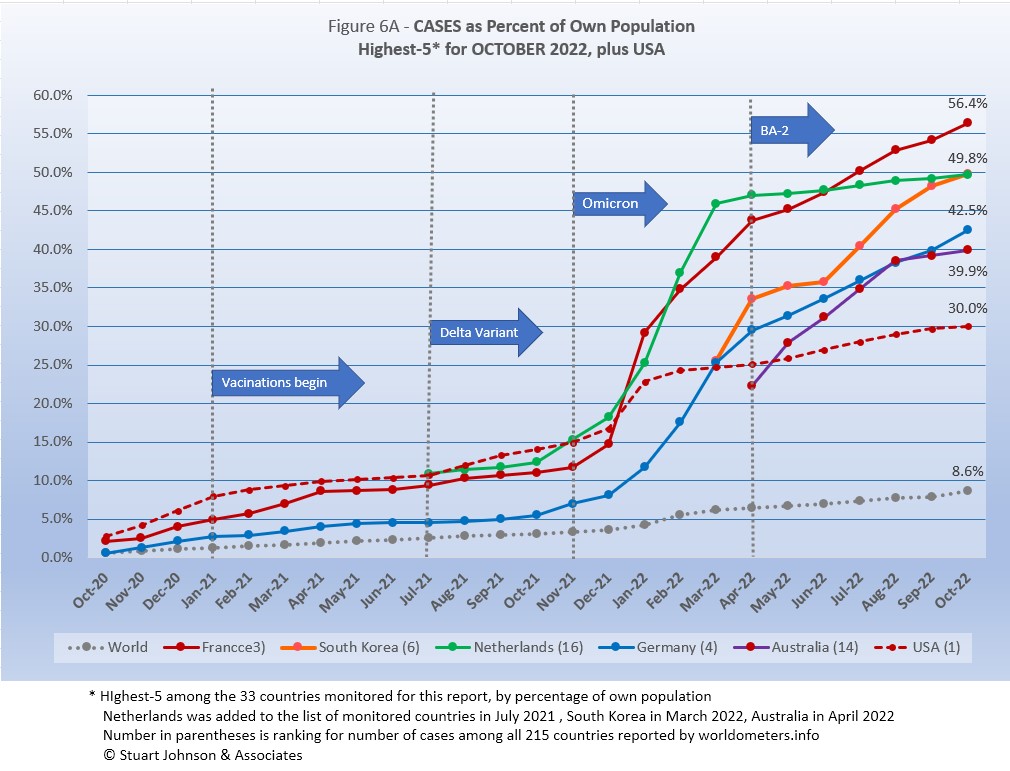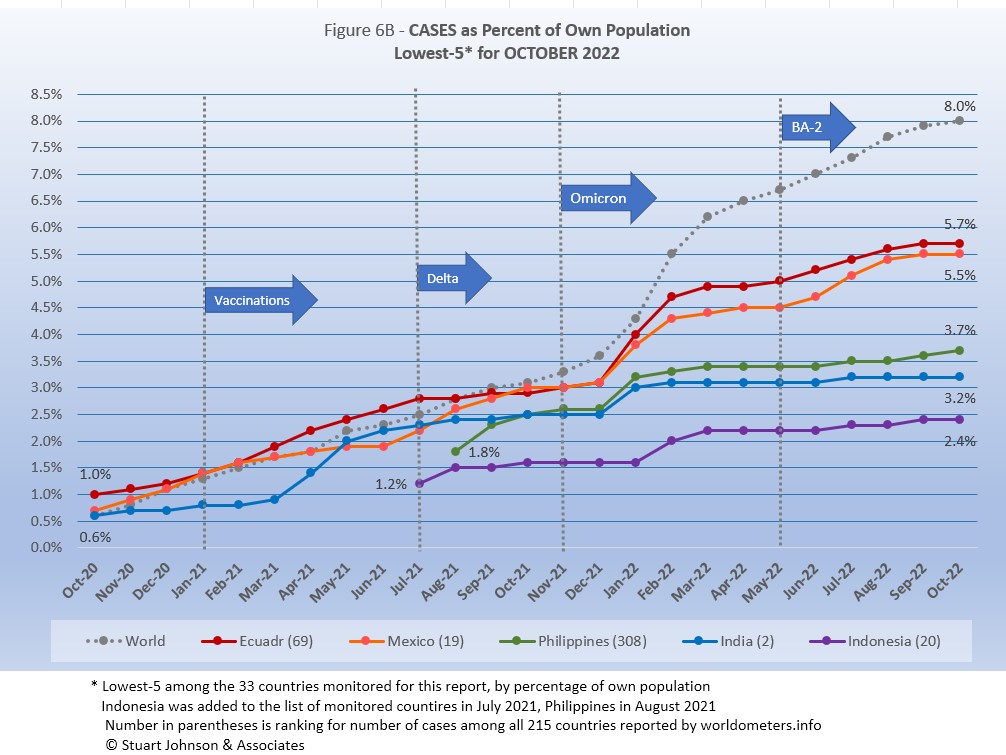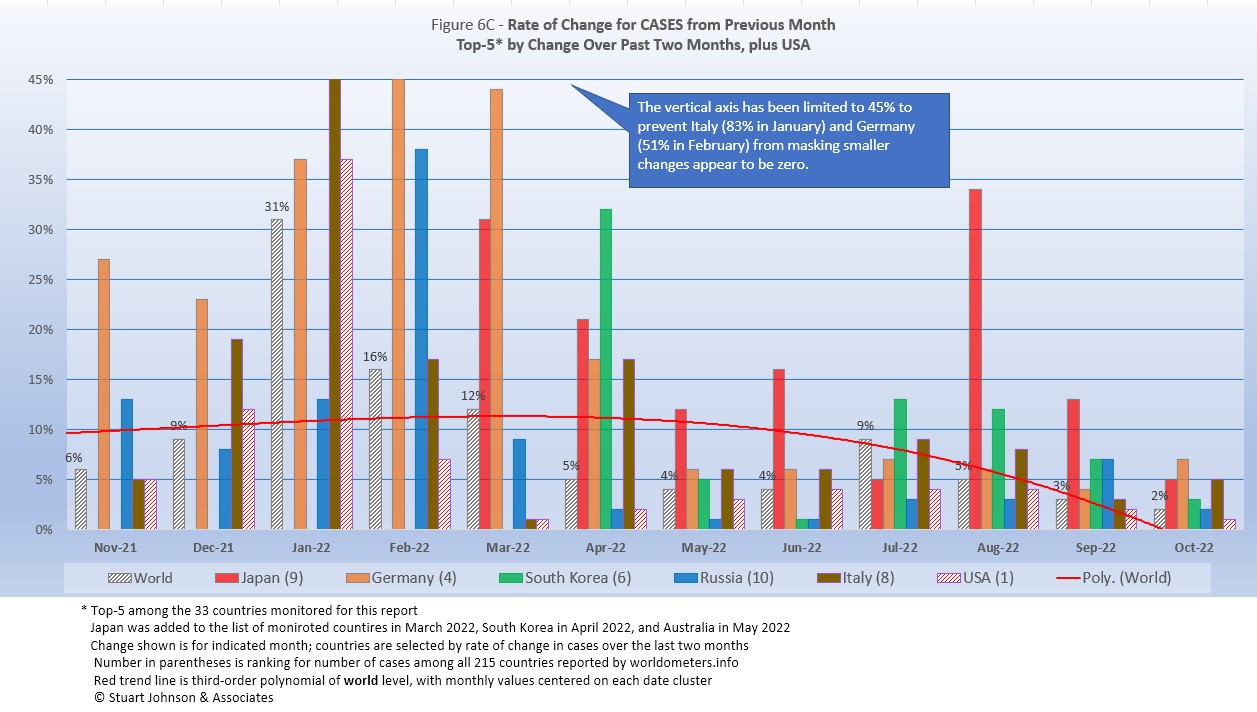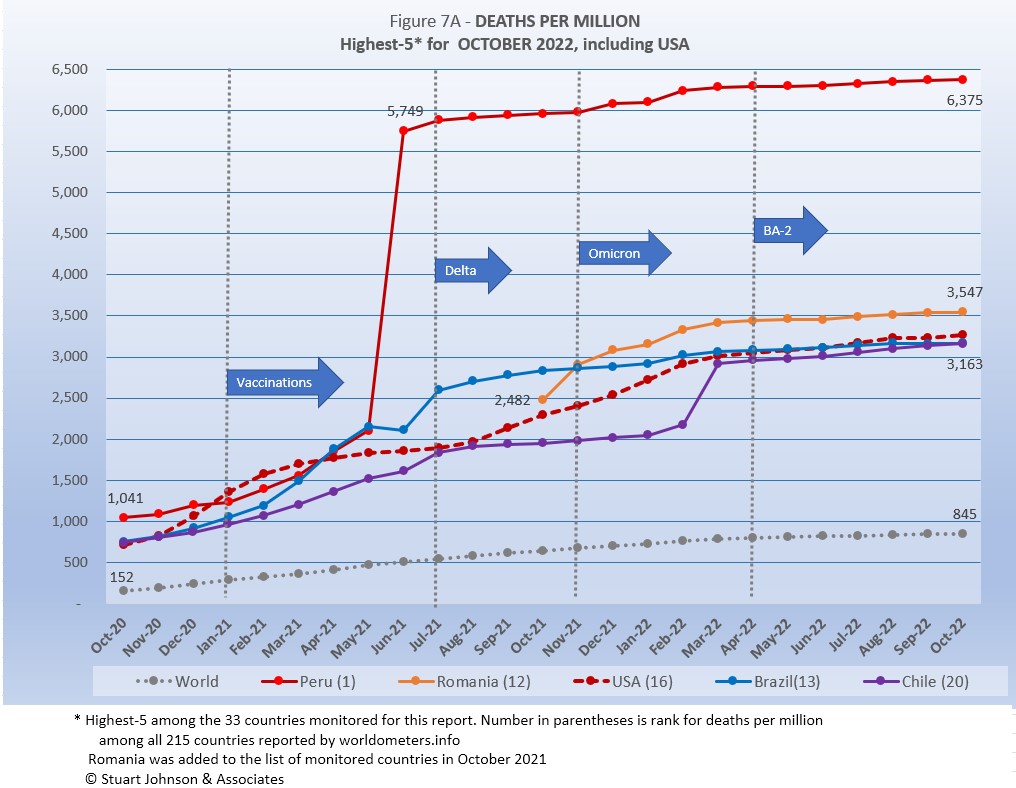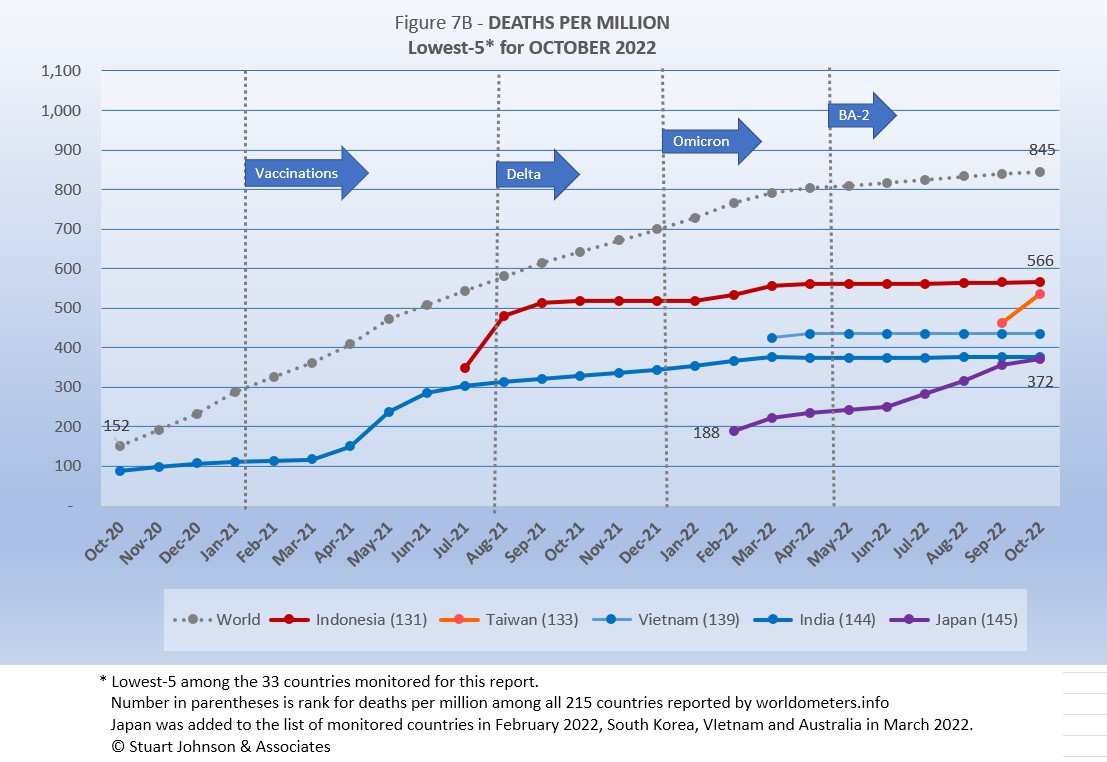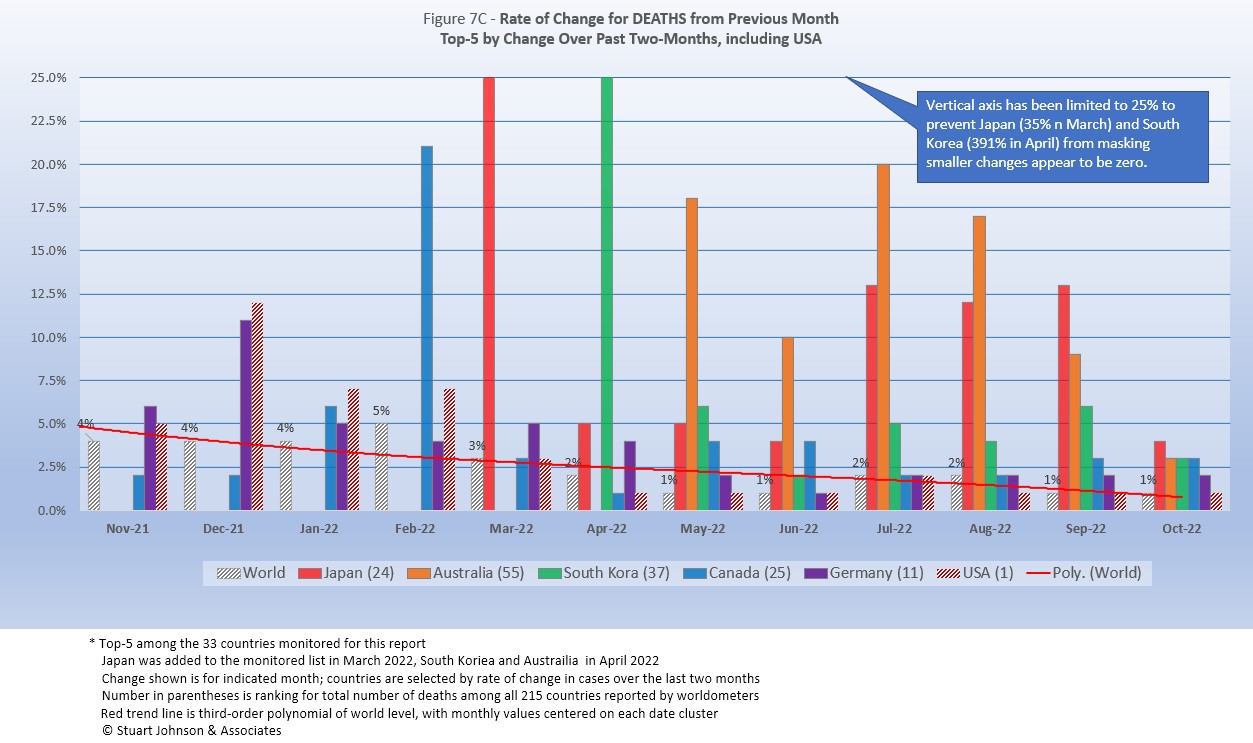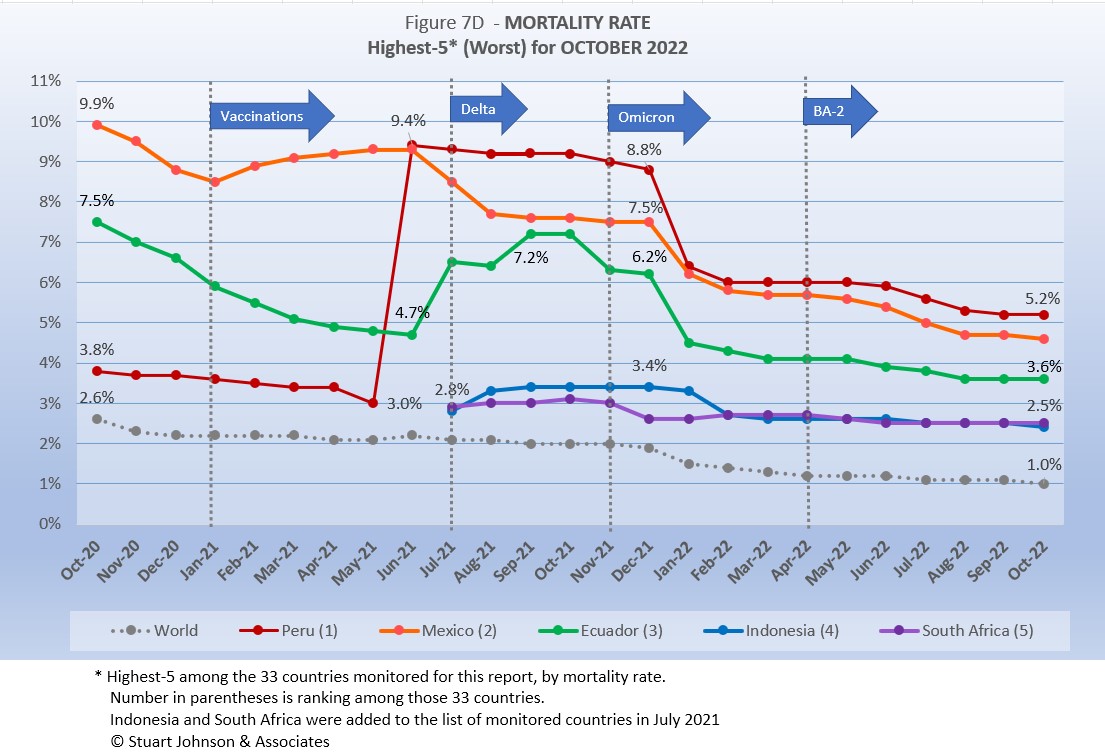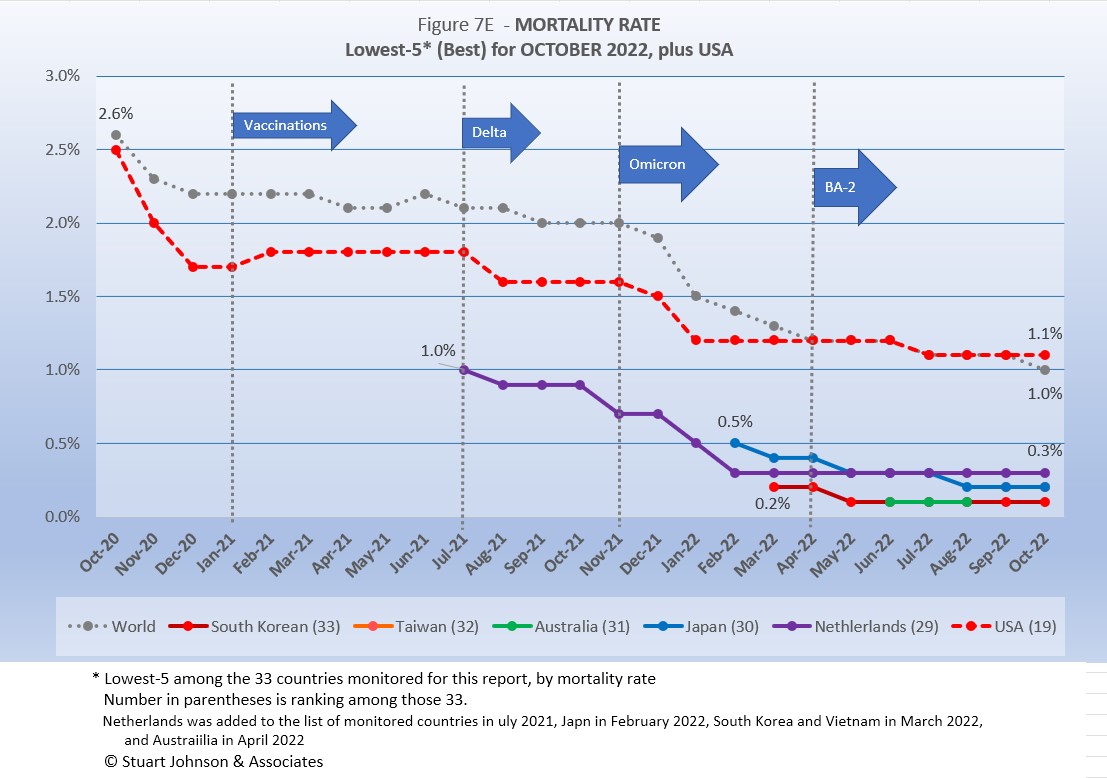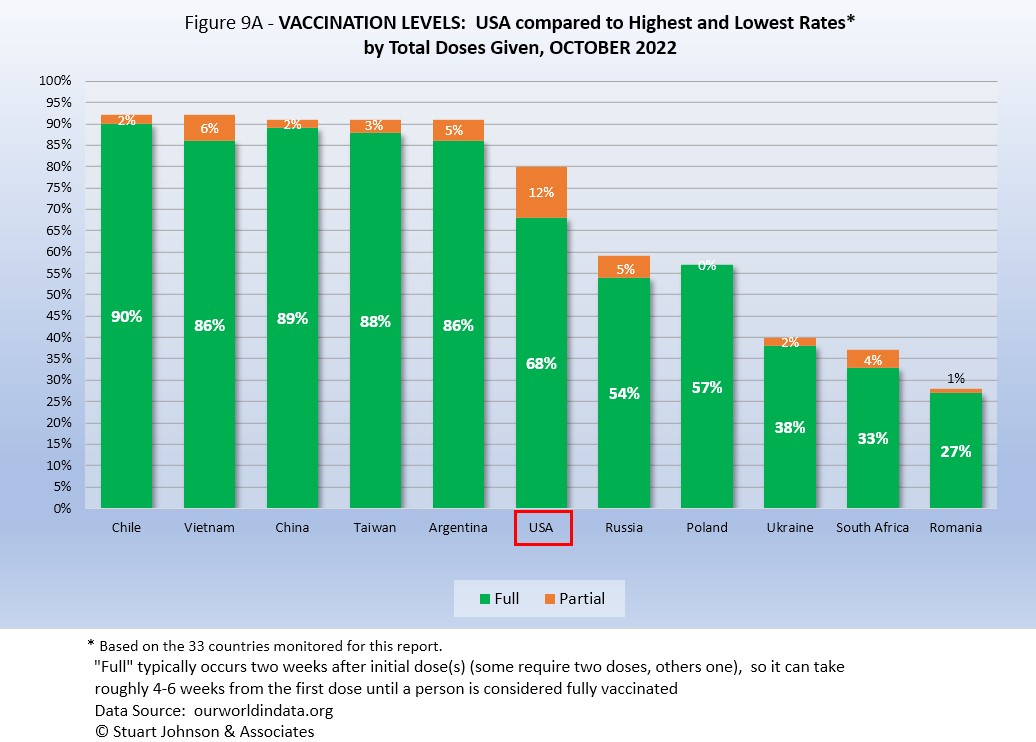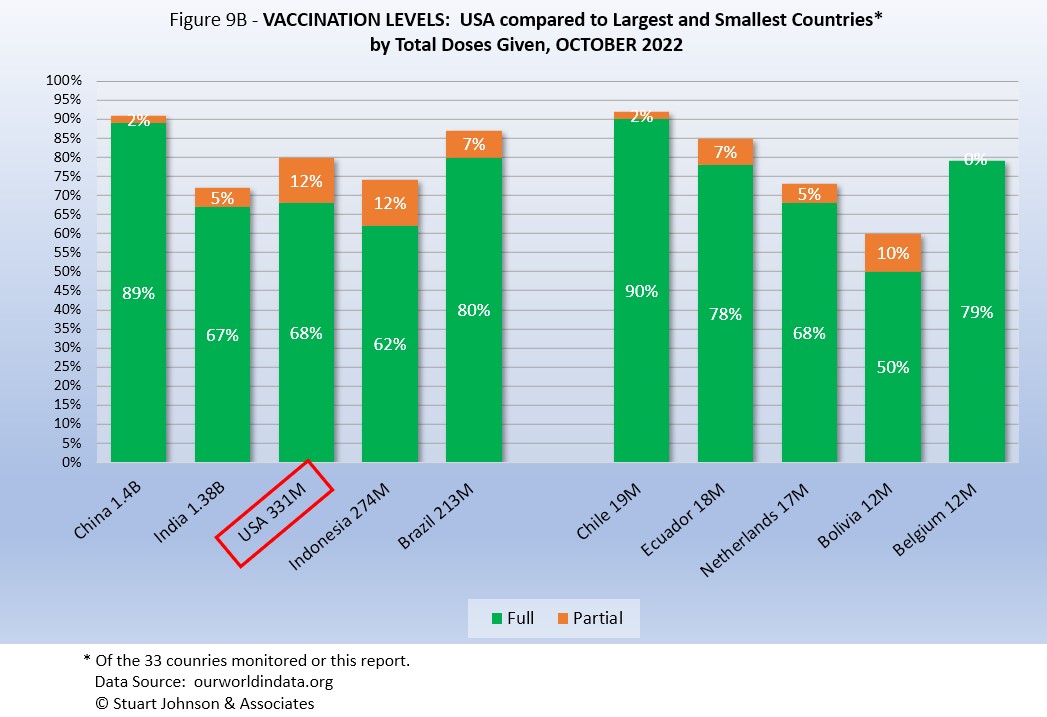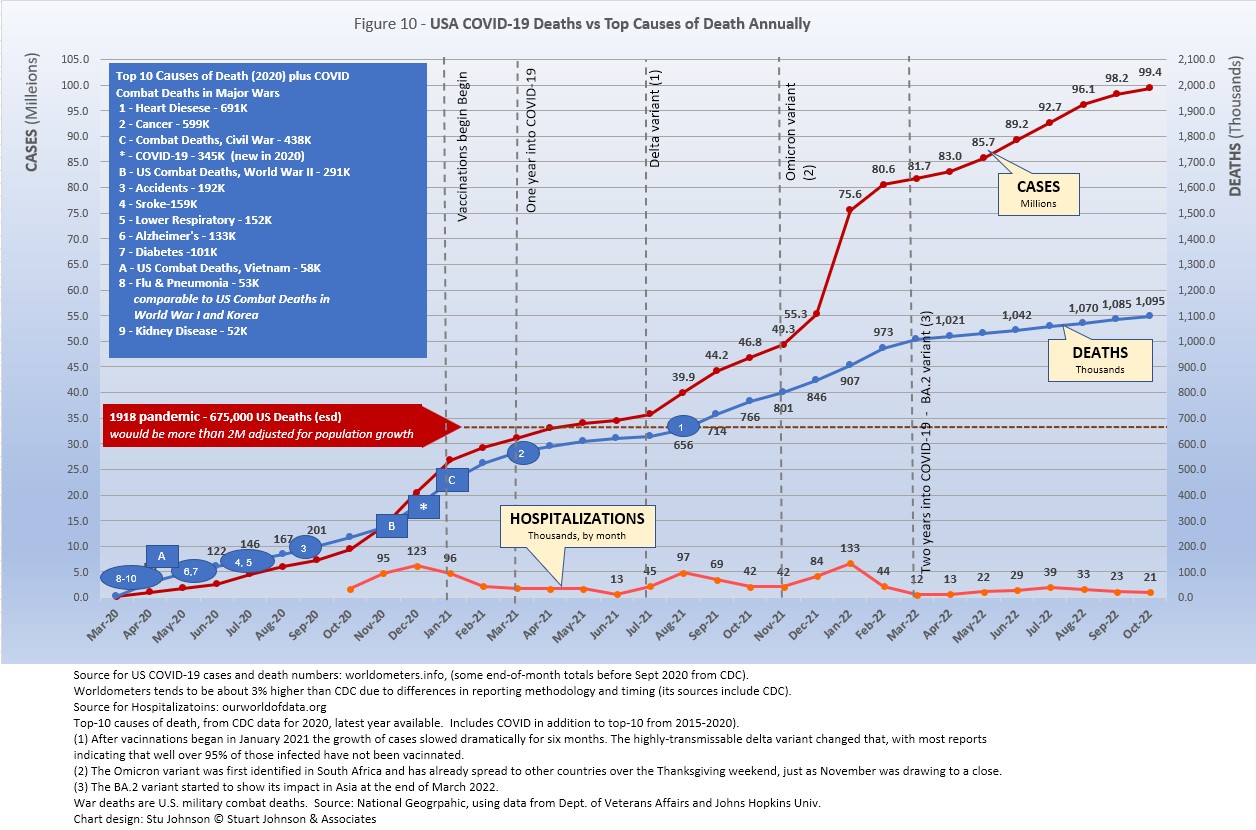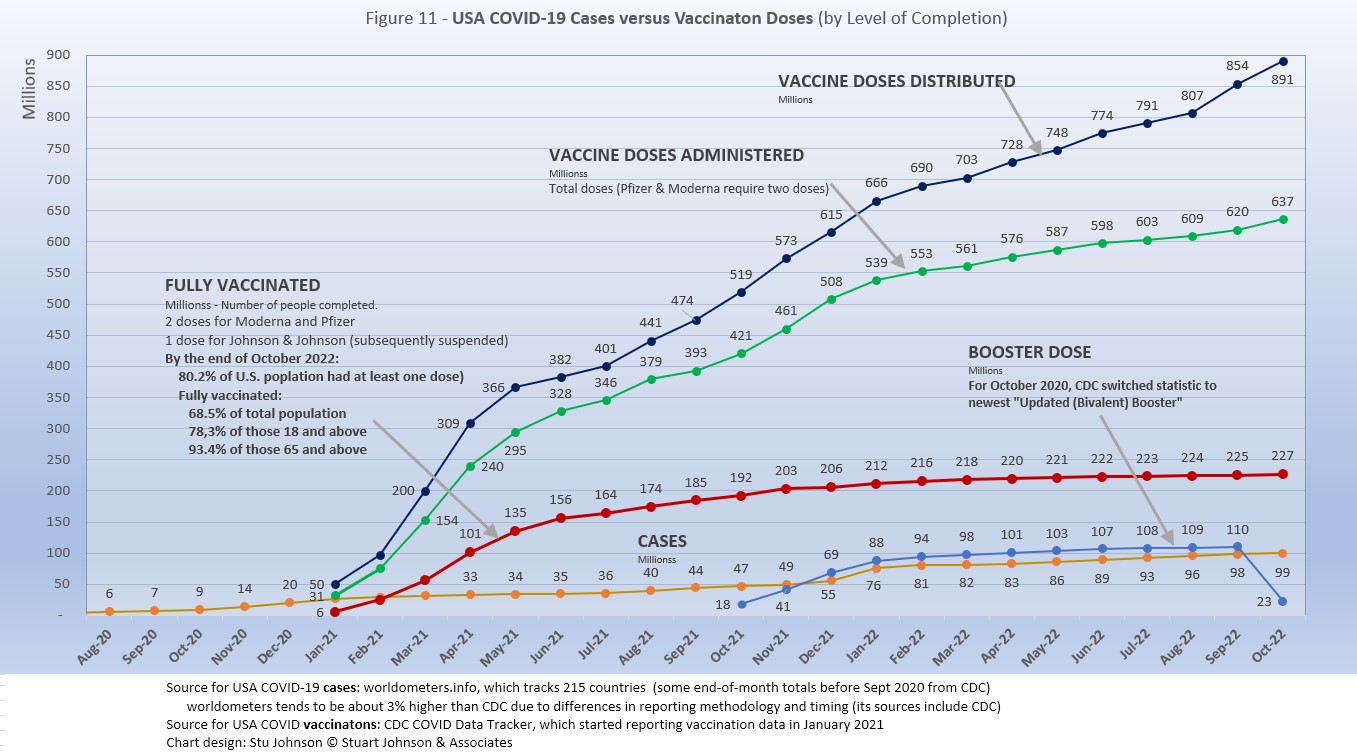





See listing of Recent and Most Popular articles on the Home Page
Health & Wellness
Category: News & Current Events / Topics: COVID-19 • Crisis • Dying and Death • Disease • History • News • Statistics • Trends
COVID-19 Perspectives for October 2022
by Stu Johnson
Posted: November 14, 2022
Are we there yet? While it seems we have turned the corner from pandemic to endemic, the global situation does not yet warrant that assessment—and the winter cold and flu season approaches in countries most impacted by COVID…
Putting the COVID-19 pandemic numbers in perspective (Number 26)
See a list of all of my articles related to COVID-19
My apologies for posting this without running it through the spell checker first. Hopefully, it is better now! SJ Nov. 15
With a lot of pressures on my time, there was no report for September, but COVID did not end in the meantime, so I'm back to observe how USA compares to the rest of the world in the ongoing pandemic.
This monthly report was spawned by my interest in making sense of numbers that are often misinterpreted in the media or overwhelming in detail (some would say that these reports are too detailed, but I am trying to give you a picture of how the COVID pandemic in the United States compares with the rest of the world, to give you a sense of perspective).
Like me, you may think that the pandemic has turned into an endemic—something that will be with us in less virulent form, like seasonal flu—but not yet (see "How you'll know when Covid-19 has gone from from 'pandemic' to 'endemic'" by Sigal Samuel, in an October 22 article on Vox).
Report Sections:
• October-at-a-glance
• The Continental View • USA Compared with Other Countries
• COVID Deaths Compared to the Leading Causes of Death in the U.S.
• U.S. COVID Cases versus Vaccinations
• Profile of Monitored Continents & Countries • Scope of This Report
October-at-a-glance
Reminder: you can click on any of the charts to enlarge it. It will open in another tab or window. Close it to return here.
GLOBAL SNAPSHOT
To most of us COVID-19 seems to be receding in the rearview mirror, but while it has slowed, the pandemic continues to spread around the world and in the U.S. This is the 26th report, now focused on 34 countries that have been at the top of the COVID statistics. Over more than two and half years, we have seen surges move around the world, with Australia and several Asian countries added to the list of countries monitored for this report in 2022. Interpreting the numbers and comparing USA with the world has been a primary concern of these reports—and the interpretation of those numbers has changed over time. To see another perspective on this, read Katherine Wu's article "Five COVID Numbers that Don't Make Sense Anymore." An excerpt was posted on SeniorLifestyle, with a link to the full article on The Atlantic website.
EXECUTIVE SUMMARY
- Globally CASES reached 635 million by the end of October 2022, a 2% increase over September, having fallen each month from a recent high of 31% in January 2022, down to 4% in .May and June, up again slightly in July and August before dropping to 3% last month. The percentage of global population with reported cases of COVID-19 rose from 4.8.% in January to 8.0% in October. (The 1918 pandemic is generally thought to have infected 25% of the global population).
The red "cone" in Figure 1 above shows a high and low projection of Global cases based on the pace of spread in the first year of COVID-19. The bottom (roughly 275 million) represents the trajectory of the lower pace in late summer 2020, the upper (approximately 500 million) represents a continuation of the major surge from November 2020 through January 2021. Even when the delta variant in 2021 was announced with alarm, the Global increase in cases stayed within the projection cone Then came omicron, which hit Europe hard in December 2021, and the curve shot through the projection cone in January then raced ahead at a very steep increase into March as it spread around the world, shooting upward by 200 million cases in three months. Slowing somewhat in April and May of 2021 It took 21 months to reach 287 million in December 2021. By the end of October 2022, cases were approaching 140 million more worldwide than had they stayed within the pace of that first major surge.
- DEATHS from COVID around the world, fortunately, continued to rise at a much slower pace than cases—fueling questions about whether the pandemic has indeed turned into an endemic. Deaths have increased 1% each of th past six moths, down from the most recent high of 5% in February and over 20% from monthly increases from late 2020 into 2021. The leveling in the global curve for deaths is obvious, falling at least 3 million short of the pace for most of 2021. That still leaves a death toll from COVID at nearly 6.6 million worldwide 32 months into this pandemic.
- BY CONTINENT. At the global level, omicron produced a noticeable bend in the curve for cases as a proportion of population (Fig. 3C),, but the huge increases for North America and Europe from December 2021 through March 2022 were dampened at the global level by much lower increases in Asia and Africa, which dominate global population. The level of global proportion of cases rose from 3.6% in December 2021 to 8.0% in October 2022, with Europe rising dramatically in that time, hitting one-third of world cases (33.3%) in December 2021, then continuing to climb at a much slower pace to end October at 36.9% of world cases. Meanwhile, Asia dropped as Europe rose, but is back to where it was in June 2021, just over 30% of global cases in the last three month. South and North America have slowly dropped in proportion, from a combined high of 46% in January 2021 to a low of 28.6% in October.
- USA continues to lead the world in the number of reported cases and death. While it leads the world in the number of COVID tests its vaccination rate remains lackluster in comparison to other countries (which keeps the death rate higher than it could be).
- While the 99.4 million CASES represents 30.0% of its own population—up from 29.7% in September—the US proportion of world cases dropped from 20.1% in January to 15.6% in October. At the same time, surges in Europe and Asia pushed cases in France to 56.6% and South Korea to 49.8% of their populations by October. Europe, with just over 10% of world population, accounts for 36.9% of reported COVID cases in the world.
The blue projection cone surrounding USA cases in Figure 1, based on the same timeline as the global cone described above, stretched from 75 to 150 million cases, with the curve for cases staying well within those bounds. Cases in USA flattened significantly from January through July 2021 after vaccinations became available, Then, it rose slightly through November 2021 with a combination of delta and vaccine resistance. Omicron produced a serious upward bend in January 2020, then slowed in February, staying in the middle of the projection cone since then.
The upward bend for USA cases since December 2021 is clearly visible in Figure 1, but even more pronounced in Figure 10 below, which "zooms in" on USA. Figure 11 provides a detailed view of USA vaccination.
Figure 1 also shows how much lower cases in USA would be—approaching 25-million by now, instead of 99 million—if they were proportional to the global population. It would also mean about 280 thousand deaths instead of more than 1.1 million.
- USA DEATHS continue to represent a proportion of world COVID deaths far in excess of its 4% share of world population. (China and India represent roughly one-third of world population between them). USA deaths declined from 20.9% of the world total in September 2020 to 14.5% at the end of August 2021, before inching up again, to 16.6% in October 2022.
-
HOSPITALIZATIONS for COVID in USA were reported at 21,409 in October, down 8% from September, and down considerably from the high of 133 thousand in January 2022 when hospitalizations related to omicron peaked.
- THE OMICRON VARIANT emerged at the end of November 2021 and hit Europe hard, bringing back lockdowns and severe restrictions in several countries. In January the surge became turbo-charged and spread to North America and to a lesser but noticeable extent to South America and Asia. In April, the increase in Asia continued, while North America had slowed considerably. While deaths can follow well behind increases in cases, it appears that both delta and omicron have had minimal impact on the pace of COVID deaths as mortality rates (deaths as a proportion of cases) continue to fall. This also appears to be true of BA-2 and its string of sub-variants, which are causing surges in cases in Asia (and perhaps the slight uptick in USA cases), without a rise in the curve for deaths. While new patterns could emerge, omicron has had the most impact of the three major variant waves so far.
- TESTING. USA leads in the number of tests, with over 1 billion, followed by India, UK, Russia and France. Because home tests have been available for a while (and do not contribute to statistics) and reported resting trends have not changed for several months, the section on Tests is not longer meaningful, so that section of the repost has been scaled back in size this month. .
- VACCINATIONS. 68% of the world's population have been reported as receiving at least one dose of vaccine by the end of October. (See figures 5A, 5B, 5C, 9A, 9B and 11).
South America leads the world in vaccination, with Chile reporting 90% fully vaccinated. Ironically, Chile suffered a major surge of cases and deaths in March that continued through May, which may be explained in part by differences in efficacy of available vaccines. USA has plateaued, with 68% fully vaccinated and another 12% partially vaccinated by the end of October, increasing only 15 million since January, a rate that is slower than the growth of cases (up 23 million in that time).
- COUNTRIES TO WATCH. Of the top ten countries by population, Pakistan, Nigeria and Singapore have not reached the threshold (the top-20 in cumulative number cases or deaths) I have used for inclusion in my list of monitored countries.
The weekly comparison report on worldometers.info gives a sense of hot spots to watch—countries not among the 34 already monitored for this report. Based on weekly activity, this includes Hong Kong, Austria, Hungary, Singapore, Greece and Czechia,. all in the top 20 of new cases and/or deaths in late October/early November. While some of these have populations too small to make much of an impact on this report, they generally confirm the continued spread of COVID in Europe and Asia.
Where you get information on COVID is important. In an atmosphere wary of misinformation, "news-by-anecdote" from otherwise trusted sources can itself be a form of misinformation. As I go through the statistics each month, I am reminded often that the numbers do not always line up with the impressions from the news. With that caveat, let's dig into the numbers for June 2022.
THE CONTINENTAL VIEW
The most obvious trend in May is accelerating cases in Asia, continued spread in Europe while North America and most of South America has been slowing in the spread of reported cases. It is likely that a significant number of people who have been vaccinated are suffering breakthrough infections, but few require hospitalization and death.
While COVID-19 has been classified as a global pandemic, it is not distributed evenly around the world.
COVID cases now represent 8.0% of world population. (By the end of the 1918 pandemic, it is generally reported to be about one-quarter of the population.) Where Asia and Africa combined represent about three-quarters (76.9%) of the world's 7.9-billion people, Europe, South America and North America still account for 2 out of 3 COVID cases (66.6% - Figure 3A) and nearly three-quarters of COVID deaths (73.4% - Figure 4A).
From a low of 25.2% of world cases in September 2021, Europe climbed to 37.2%by April 2022 as a result of surges from the the omicron variant and has very slowly declined to 36.3% by October as Asia has steadily increased throughout 2022, from 26.6% to 30.5% of world cases. Meanwhile, South America and North America continue to slowly shrink in proportion of world cases, down to 10.1% and 18.5% respectively. The proportion of cases for South America is getting close to its proportion of population of 8.4%, but cases in Europe and North America remain far above their proportion of world population.
Overall, Europe is up 9% in proportion of world COVID cases since the chart begins in November 2020, while Asia is up 4% and the others down: Africa 1%, South American and North America both about 7% (all within a fraction of last month's measures).
While Africa shows only the slightest deviation from its low and slow growth in Cases, the presence of omicron is very visible for the other continents, with the pace slowing for each following one to three months of rapid growth.
Europe shows the greatest impact in number of cases since omicron appeared in late November 2021. After being virtually tied with Asia in December, Europe has seen its COVID cases rise 169% since then, while Asia increased by 123%. Both have slowed since March, but continue to track close to each other, at a pace faster than the other continents. North America increased significantly in January, then slowed below the pace of Europe and Asia..(Had the January rise continued, it would have caught up with Asia in number of cases by March or April). South America saw the lowest post-omicron increase. The Americas were obviously hit by omicron, but to a lesser and shorter degree than Europe and Asia, making their curves bend down sooner and deeper.
The raw numbers of Fig. 3B can be deceptive. Fig. 3C gives a more realistic picture of the impact by translating raw case numbers to percentage of population. (By contrast, Figure 3A is distribution of global cases). The shape of the curves is similar to those for raw numbers, but the order and spacing paints a different picture.
The impact of omicron is clearly evident, with the Global share of COVID cases increasing from 3.6% in December 2021 to 6.2% in March, then growing at a slower pact to 8.0% by the end of October, Europe has seen the biggest increase, rising steadily for three months, with a slight slowdown in April and May, then continuing to stay slightly ahead of North America until slowing down in September and October to close the gap with North America.
South America stays above the Global level, but at a slower rate.. Asia and Africa remain below the Global level, Asia increasing noticeably since omicron became evident, but at a slower rate than the Global level. Africa remains far below the Global level and shows only the slightest increase due to omicron.
The proportion of deaths between continents shows less extreme change than that for cases. In fact, given the increase in proportion of cases for Europe over the past year (Fig. 3A), the continental share of COVID deaths has remained remarkably stable. The changes in Fig. 4A can be divided into five stages by time (the pattern is similar for cases in Fig. 3A, but not as obvious as it is here)
- February/March 2021 - Low point for Asia and South America, as Europe and North American increase in proportion of deaths.
- July-September 2021- Asia and South America grow in proportion as Europe and North America shrink
- October 2021 - October 2022 - relative stability, with Europe growing in early months as South America shrinks, but Asia and North American changing little.
Overall, Asia is up 3% in proportion of COVID deaths from where the chart starts in November 2020, Europe is up more than 2%, Africa is up less than 1%, while South America is down nearly 2% and North America is down 4%.
The most notable characteristic of deaths is the growing detachment from cases. Unlike the first year of the pandemic, when deaths went up dramatically with surges in cases, the death rate (compare it with cases in Figure 1) has slowed significantly even as cases continue to climb.
Deaths through October 2022 show that while the trajectory lags behind cases and has progressed at a steadier rate, it does reflect the overall changes in Cases by continent. Having crossed the 1 million mark a year ago, Europe us closing in on 2 million deaths.
While the omicron surge in Europe went "through the roof," what is interesting here is that the death rate actually took a turn downward in January, with a very slight upturn in February and March, and a nearly imperceptible slowdown starting in April. The relative steadiness in the path of each curve shows that the death rate has remained much more constant over time than cases, which tend to surge in varying degrees with each new variant. And, as we'll see later, mortality rates (deaths as a proportion of cases) continue to fall.
Vaccinations
Growth in vaccinations is at a virtual standstill. As Fig. 5A shows, two thirds of the global population (68%) has been reported with at least one dose of vaccine, and six in ten (63%) are fully vaccinated, an increase of only 1% in fully vaccinated since August. That is still well below what is commonly thought of for "herd immunity," which is closer to 94% of the population being immune (most through vaccination), but is remarkable nonetheless given the enormity of the effort represented in little over a year since vaccines became available.
South America, which was slow to get into testing and vaccination, soared ahead of the other continents toward the end of 2020, then took the lead in total vaccine doses in August 2021. Asia pulled past North America in March 2022 with 74% of total vaccinations, tied at 76% in May, then North America pulled ahead again in June with 79% total vaccinations, though Asia was well ahead in fully vaccinated at 72% (much of this was due to counties like South Korean and Vietnam with high vaccination rates that have been added to the list of monitored countries in recent months). . . Europe, impacted the most with omicron-related surges, remains in fourth place with 69% total vaccinations and 66% fully vaccinated, putting it ahead of North America and the world level for fully vaccinated.
While South America got into vaccinations later and slower than North America and Europe, Figure 5B shows how it steadily pushed its way to the top of total vaccination doses administered by August 2021, expanding its lead through early 2022 before a global slowdown in the proportion of total vaccine doses. Europe has leveled off more noticeably than Asia and the Americas, which continue very slow growth at a pace comparable to the global curve. After more than a year of slow but steady growth, Africa also leveled off in October.
COMPARISON OF USA WITH OTHER COUNTRIES
Cases
Raw numbers are virtually meaningless without relating them to the size of a given country, so looking at cases as a proportion of population helps get a sense of the relative impact. The countries with the greatest proportion of COVID cases illustrates how they amplify the world trend for cases (bottom line in Figure 6A),
Since the last report for August, South Korea has moved up into second place, pushing Netherlands down to third place, and Germany has replaced Belgium. While all showed an accelerating pace in response to omicron, all bu Netherlands (and USA) were closer to the global pace, which shows very little influence so far from BA-2 and its variants.
France ended October with 56% of its population having been reported with COVID infections at some point, passing Netherlands in June. Netherlands has slowed over the last eight months, with little evident impact from BA-2 and its variants but still ended October at the 50% mark. South Korea has been rising rapidly in cases as a proportion of population, barely surpassing Netherlands in October to move into second place. Germany, which replaced Belgium in the top-5, follows a pattern similar to France, with nearly 43% of its population having had confirmed cases of COVID. Australia saw rapid growth when it joined the list of monitored countries in April, but has slowed since August, keeping it in fifth place. Meanwhile, USA looks more like Netherlands: though its omicron-related increase was far smaller, it shows a significant slowdown n the increase of cases by proportion of population through most of 2022. All six (top-5 plus USA) remains well above the global proportion of cases, which stood at 8.0% at the end of October. While all six (and 10 of the 34 monitored countries) have surpassed the 25% level of global infection in 1918, the significant difference remains a much lower mortality rate than a century ago.
Another way to look at population proportion is the measure "1 in." The global figure of 8.0% means that 1 in 12 people in the world have been reported with COVID-19 since it began (and that only by official record keeping, not including any unreported and likely asymptomatic cases). For France, South Korea and Netherlands, it is 1 in 2; for Australia and USA it is 1 in 3.
All five countries (of the 34 monitored) in the bottom-5 by proportion of population have been there, in this order, since December 2021.
At the scale of this chart, the rise in Global case proportion is magnified compared to the previous chart, so it clearly shows the acceleration of cases produced by omicron around the world since November 2021. Al five countries show a rapid upturn followed by a leveling off (with varying impact from BA-2 and its sub-variants as this point).
These countries represent a considerable spread in size, from India, the second largest country, to Ecuador, ranked number 67 of the 215 countries tracked by worldometers. For Ecuador, its 5.7% of population means that 1 in 18 have been reported as having had the COVID virus; for India it is 1 in 31, and for Indonesia 1 in 42.
Because the size of countries makes the use of raw case numbers illusory, another measure I find helpful is the rate of change from month to month (Figure 6C). The focus of the selection is on recent changes, but the chart covers 12 months..
For this chart, countries are selected based on the change over two-months (end of August to the end of October). For the chart this month Germany and Russia replaces Australia and Bolivia.
.
The overall trend (red line, reflecting global level) had been climbing, up to a 31% change in January, reflecting the large impact of the omicron variant. Since then it dropped to a monthly change of 4% in May and June, then up to 5% for July and August (likely in response to BA-2), then back down to 3% in September and 2% in October.
The changes in the last two months are far lower and closer to the global level than was true in the opening months of the chart, which reflect omicron-related surges. Japan,which was added to the list of monitored countries in March, shows the largest changes from month to month, far above the global level, with the resurgence in July that interrupted a downward trend starting in July.
The chart below shows how the top-5 has shifted since May 2021, from dominance by Asia and South America in mid-2021, to resounding impact of omicron on Europe in the past four months, before broadening out in March 2022. By June, Europe was down to two countries in the top-5 by 2-month change, Asia down to one, and new entries for Oceania (see not at bottom of chart) and South America. North America, dominated by USA but influenced by Canada and Mexico, has made the fewest appearances in this chart.
| Month | Top-5 for Increase in Cases Over 2 Months | Note | ||||
|---|---|---|---|---|---|---|
| May 2021 | India | Argentina | Turkey | Iran | Columbia | Asia surging |
| June 2021 | India | Argentina | Colombia | Bolivia | Chile | South America surging |
| July 2021 | Colombia | Iran | Argentina | UK | Bolivia | Delta appears |
| August 2021 | Iran | UK | Mexico | Turkey | Russia | Delta rising |
| September 2021 | Iran | UK | Mexico | Turkey | USA | Delta fading |
| October 2021 | Philippines | UK | Ukraine | Turkey | Russia | Mixed |
| November 2021 | Belgium | Ukraine | Germany | UK | Netherlands | Omicron appears |
| December 2021 | Germany | Belgium | Netherlands | UK | France | Omicron intensifies |
| January 2022 | France | Italy | Spain | Belgium | Canada | Omicron intensifies |
| February 2022 | France | Italy | Germany | Netherlands | Spain | Omicron intensifies |
| March 2022 | Germany | Netherlands | Chile | Russia | Malaysia | Omicron spreads |
| April 2022 | Germany | Japan | Malaysia | Italy | Netherlands | Back to Europe, Asia |
| May 2022 | South Korea | Japan | Germany | Italy | France | BA-2 variants spread |
| June 2022 | Australia | Japan | Germany | Italy | Chile | Disbursed |
| July 2022 | Japan | Australia | Italy | South Korea | Chile | Disbursed |
| August 2022 | Japan | South Korea | Australia | Bolivia | Italy | Disbursed |
| September 2022 | Japan | South Korea | Australia | Italy | Germany | Europe surging |
| October 2022 | Japan | Germany | South Korea | Russia | Italy | Back to Europe, Asia |
| Color Legend: Continent assignment as defined by United Nations and used by worldometers.info | ||||||
| Asia | Africa | Europe | S America | N America | Oceania | |
to other continents, it is included here because of the presence of Australia in the list of monitored countries.
Deaths
Because deaths as a percentage of population is such a small number, the "Deaths-per-Million" metric shown in Figure 7A provides a comparable measure. It is different than mortality rate, which is a measure bases on deaths as a proportion of cases.
The same five countries return to this month's top-5, in the same order since July.
The Global curve for deaths-per-million shows a very steady growth, despite surges, vaccinations and variants that had a much more obvious influence on cases. In fact, it has been slowing ever so slightly (put a straightedge on the global line and you will see that it is not straight, but gently curving down over time).
As Figure 7A shows, Peru still soars over the others following a correction to its death data in June 2021. It shows a slight increase in the death rate with omicron starting in January, remaining about double the remaining four, which all rose faster than the Global rate. Since BA-2, all five are pretty much tracking the global rate of increase.
USA moved into number 3 in July and appears to be growing slightly faster than the global level, along with Chile, though Brazil has leveled off more. All three (USA, Brazil and Chile) have been very close since they covered following omicron in March 2022.
Given lower death rates in European and Asian countries that experienced much higher surges in cases, it is striking that USA, whose case rate has been much more moderate, finds itself in the company of countries with the highest death rates as measured by deaths-per-million-population. That situation should lead to serious consideration of what could have been done better, especially as political and ideological division drove the split between over-zealous use of lockdowns in the name of Science and the ethos of a "don't tread on me" individualism, a division that soured the often heroic efforts of the health care system.
All of the countries on the chart are well above the Global level, and (except for Peru) remain fairly close to each other.
The five lowest of monitored countries by deaths-per-million are all Asian. Indonesia replaces Australia in this month's chart. Taiwan was added in September, replacing South Korea, but I did not produce a report last month.
Japan and Taiwan, both recent additions to the list of monitored countries, are below the global level of deaths-per-million, but increasing at the faster pace. In contrast, Vietnam, India and Japan have all been leveling off since March, before BA-2 began producing surges in cases (even in Japan and South Korea).
The Global rate of increase in deaths-per-million was very steady through March 2022 when it began a noticeable slowdown, even as BA-2 and its sub-variants began to emerge, increasing the widening gap between cases and deaths—the bit of good news in this pandemic.
As with the comparable chart for Rate of Change for Cases (Figure 6C), countries for Rate of Change for Deaths (Figure 7C) are selected based on the change over two-months (end of August to end of October) in reported COVID deaths. The focus of the selection is on recent changes, but the chart goes back 12 months for perspective.
Germany replaced Spain in September, with the top-5 in October carrying over to October.
The global rate of change by month (red trend line) rose from 4% in November 2021 to 5% in February 2022 before declining to 1% in September and October.
Japan had the largest two-month change, but all five fell dramatically in October (both Japan and South Korea had extremely high one month changes (the reason the chart's vertical axis is truncated), but for both it was at the front end of surges where relatively small changes in numbers can exaggerate percentages. For both countries, the monthly changes since those highs are more representative. In fact, over the past six months, Australia has seen greater month-to-month change than either Japan or South Korea.
Germany and Canada are included in the top-5 simply because their numbers, while low, remain slightly above the average for the 34 monitored countries, where two-thirds are now below the 1- or 2-month global change in deaths of 1% and 2%. In fact, in October half of the list showed no percentage change from September. Taiwan, added to the list of monitored countries in September, saw a 16% increase in deaths from September to October. Next month, when the two-month change can be measured, it will likely appear in the top-5.
Contrast this chart with the one for cases above. The chart below shows how the top-5 has shifted since May 2021, from dominance by South America to a mix of Asia and Europe, then a dominance of Europe, followed by a broadening mix as omicron spread and renewed evidence of increasing deaths in Asia in May 2022 as BA-2 and its sub-variants began to spread.
| Month | Top-5 for Increase in Deaths Over 2 Months | Note | ||||
|---|---|---|---|---|---|---|
| May 2021 | India | Turkey | Brazil | Colombia | Argentina | Tilt toward S America |
| June 2021 | Peru | India | Argentina | Colombia | Bolivia | South America surging |
| July 2021 | Peru | Ecuador | Colombia | Argentina | Russia | South America surging |
| August 2021 | Ecuador | Russia | Iran | Argentina | Colombia | South America fading |
| September 2021 | Indonesia | Iran | Russia | Turkey | Malaysia | Asia surging |
| October 2021 | Philippines | Russia | Ukraine | Turkey | Iran | Asia surging |
| November 2021 | Ukraine | Russia | Philippines | Turkey | Malaysia | Omicron beginning |
| December 2021 | Ukraine | Russia | Poland | Romania | Philippines | Omicron growing |
| January 2022 | Poland | Russia | Ukraine | Germany | Turkey | Omicron surging |
| February 2022 | Canada | USA | Poland | Turkey | Russia | Omicron surging |
| March 2022 | Chile | Canada | Turkey | Russia | USA | Omicron spreads |
April 2022 |
Chile | Japan | Germany | UK | Russia | Europe returns |
May 2022 |
South Korea | Chile | Japan | UK | Germany | Asia rising with BA-2 |
June 2022 |
Australia | South Korea | Canada | Japan | Germany | Shifting East |
July 2022 |
Australia | Japan | South Korea | Canada | Spain | Solidifying East |
August 2022 |
Australia | Japan | South Korea | Canada | Spain | Solidifying East |
September 2022 |
Japan | Australia | South Korea | Canada | Germany | Solidifying East |
October 2022 |
Japan | Australia | South Korea | Canada | Germany | Solidifying East |
| Color Legend: Continent assignment as defined by United Nations and used by worldometers.info | ||||||
| Asia | Africa | Europe | S America | N America | Oceania | |
to other continents, it is included here because of the presence of Australia in the list of monitored countries.
Mortality Rate
Mortality Rates (percentage of deaths against reported cases) have generally been declining. This is not surprising as several factors came into play:
- In the early days of the pandemic, there was a high proportion of "outbreak" cases (nursing homes, retirement communities, other settings with a concentration of more vulnerable people). As the pandemic continued the ratio of "community spread" (with lower death rates) to "outbreaks" increased and the overall Mortality Rate went down.
- As knowledge about treatment increased, mortality went down.
- Since the death count is more certain (though not without inaccuracies), the side of the equation that can change the most is cases. As testing revealed more cases, the Mortality Rate would naturally go down because it would only affect cases and not deaths. In addition, the official numbers do not take into account a potentially higher number of people with the virus who are unreported and asymptomatic, so the real mortality rate could be even lower. (This will be a factor with availability now of home testing, where positives may escape official reporting).
- Vaccinations started in January 2021 and available in January 2022 was the first anti-viral drug (reducing hospitalization and death for those testing positives).
- So far, the omicron and subsequent variants have produced a continued rise in cases, but not in deaths,which is the reason the Global mortality rate started to decline more noticeably in 2022, with very steep drop in mortality as omicron drove up cases in Peru, Brazil and Ecuador.
The Global mortality rate had dropped from 2.6% in October 2020 to 2.0% by September 2021, where it stayed for three months. Interestingly and—proving the point about death rates remaining steady and actually slowing down even as cases surged—the Global mortality rate dropped to 1.2% by the end of April, 2022 before heading down to 1.0% by the end of October—in a kind of mirror image to the upward slope of the curve for cases.
The same five countries return this month. Because of a correction in its data in June 2021, Peru saw a major spike in its mortality rate, which slowly went down through December, followed by the largest decline in mortality among the five at the same time omicron was pushing up case numbers. Since February, all five have leveled off, with little or no change in mortality rate, Indonesia and South Africa have been vying for fourth place for nine months.
Since these represent the best mortality rates, where low is good, the "rank" order is actually in reverse.
In September, Taiwan replaced Vietnam and the otder shifted slightly, where it continued into October. All five are well below the global rate of 1.0$ and piling on top of each other at 0.3, 0.2 and 0.1%.
USA had been stuck at 1.2% for six months before dropping to 1.1% in July, where it has been for four months, tracking the global rate for six months until October, when the global rate dropped to 1.0%r, Relatively speaking, that is a good mortality rate, yet one-third of the monitored countries, including Belgium, Germany and Netherlands have rates below 1.0% for six months or more, largely because huge omicron-related surges were not matched with a similar increase in deaths. USA should have been able to keep deaths much lower since the surges here were well below those experienced in Europe and parts of Asia. (It is ironic that had USA experienced higher case surges its mortality rate would also have dropped, but that would only happen if hospitalizations and deaths were kept down).
Even so, without a relatively low mortality rate, the USA death rate would be far higher. Compared to the mortality rate during the 1918 pandemic, it could be ten times worse than it is. At its current mortality rate of 1.1%,(now above the global level) USA has had more than 1.1 million deaths (out of 99 million cases) by the end of October, As pointed out in Figure 1, however, if USA had cases closer to its proportion of world population, we would be looking at 280-thousand deaths out of 25-million cases. The response of the health care system and availability of vaccines are part of keeping mortality down, but the high case rate points to the conflicts already mentioned between opposing sides of the approach to COVID (extreme lockdowns in the name of science versus extreme individualism in the name of freedom). .
How real is the threat of death from COVID? That's where successful mitigation comes in. Worldwide, by the end of October, 1 in 12 people have been reported as having contracted COVID and 1 in 1,209 people have died. In USA, while the mortality rate is low, because the number of cases is so high, 1 in 302 have died through October 2022—between Brazil (1 in 304) and Romania (1 in 286). Japan and Australia, recent additions because of surging cases,are at 1 death in 2,711 and 1,665 respectively (COVID in both countries, however, has increased to the point that both were added to my list of monitored countries and those numbers, while still in sharp contrast with USA, are moving in the wrong direction). .A closer comparison would be neighboring but sparsely populated Canada, at 1 in 814, or Mexico, at 1 in 390, with most European countries between those two.
Tests
The section on testing has been reduced in size because of the availability of home testing is widespread and not tracked in the statistics. In addition, the statistics that are reported have shown no meaningful change for the past five or six months.
The point of inequality between countries still exists, however, so I will continue to update the following list, which was originally based on the lowest five for testing, but now includes other pairs of similar-sized countries among the 34 I monitor. Remember, however, that the statistics here refer only to officially reported testing and do not include home testing.
- Mexico: 18.6M tests for 128.9M population, compared to Japan: 71.6M tests for 126.5M population (3.8X the tests)
- Philippines: 33.3M tests for 109.6M population, compared to Vietnam: 85.8M tests for 98.9M population (2.6X)
- Iran: 54.4M tests for 84.0M population, compared to Turkey: 162.7M tests for 84.3M population (3.0X)
- Poland: 37.6M tests for 37.8M population, compared to Canada: 65.7M tests for 37.7M population (1.7X)
- South Africa: 26.2M tests for 59.3M population, compared to Italy: 252.7M tests for 60.5M population (9.6X)
- Peru: 35.7M tests for 33.0M population, compared to Malaysia: 65.4M tests for 56.1M population (1.8X)
- Ecuador: 3.1M tests for 17.6M population, compared to Netherlands: 21.1M tests for 17.1M population (6.5X)
- Bolivia: 2.7M tests for 11.7M population, compared to Belgium: 35.3M tests for 11.6M population (13.0X)
Of the southeast Asian countries I monitor—most relatively recent additions because of surging cases—only Malaysia and Vietnam report enough tests to cover their entire population. Otherwise, Japan, Indonesia, South Korea, and Philippines are all at testing levels that would cover roughly a third of their populations. Yet, they remain among the monitored countries with the lowest mortality rates. While they may not appear high in reported testing, they are all above global rates for total vaccinations (from 62% for Indonesia to 83% for Japan, 86% for Korea, and 90% for Vietnam.
Vaccinations
Figure 9A compares USA with the top-5 and bottom-5 of monitored countries by total doses administered. As you can see USA leans toward the upper countries, its total vaccination rate showed virtually no increase in October*, and that remains below the full vaccination rate for all of the top-5. On the other hand, USA is well ahead of the bottom five of the 34 monitored countries for both total doses and fully vaccinated.
As pointed out in other parts of this analysis, Figure 9A does not tell the whole story. It's a bit of an apples and oranges comparison, with one major factor being the population of each country.
*Numbers for this chart come from ourworldindata.org. The CDC numbers, used in Figure 11, show similar results, with less than 1% increase in doses administered and less than half a percent for those fully vaccinated (two doses), producing a one percent increase in partial vaccination and no increase in fully vaccinated (by percentage) since my last report in June.
Taking population into account paints a somewhat different picture for USA compared to other monitored countries. In Figure 9B you see the five most populous countries on the left and the five smallest (of those monitored for this report) on the right.
China and Brazil are ahead of USA in both full and total vaccinations. USA is ahead of India and Indonesia in both total doses and full vaccination. .
On the side of the smallest countries, Chile is ahead of all five of the largest countries, but the disparity in earlier months is decreasing as the larger countries (except for USA) continue to improve their vaccination rates.
In USA and perhaps in other large countries, individual regions, provinces or states may be doing as well as some smaller countries, while the entire country lags behind the smaller ones.
CAUSES OF DEATH IN USA
Early in the reporting on COVID, as the death rate climbed in USA, a great deal of attention was given to benchmarks, most notably as it approached 58,000, matching the number of American military deaths in the Vietnam War. At that time, I wrote the first article in this series, "About Those Numbers," looking at ways of viewing the data, which at the time of that writing in May 2020 was still focused on worst-case models and familiar benchmarks, like Vietnam.
Three Critical Curves
Figure 10 shows the number of USA COVID cases and deaths against the top-10 causes of death as reported by CDC. That data was updated this month to show 2020 figures, the latest year available. COVID-19 deaths for 2020 are included, but I have kept the numbers 1 to 10 reserved for causes that appeared in earlier reports. The chart also shows hospitalizations going back to October 2020.
Notice that for nearly nine months, the curve for deaths was increasing at a faster rate than cases. Then, starting in October 2020 the curve for cases took a decided turn upward, while deaths increased at a more moderate pace (the two curves use different scales, but reflect the relative rate of growth between them).
Unlike the case and death curves, which are cumulative, hospitalizations reflects the number of cases requiring hospitalization each month. You can see three peaks: the first with the initial surge (before vaccines became available) in December 2020, followed by August 2021 (delta) and January 2022 (omicron), which now represents the peak of hospitalizations. Notice, however, that the relative spread of cases-to-hospitalization is enormously different for omicron. In December of 2020, there were roughly 6.5-million new cases where January 2022 saw 20.3-million (a 212% increase), yet hospitalizations were only 11-thousand higher (8%).
Benchmarking the Numbers
Media reporting tended to focus on easily grasped benchmarks—deaths in Vietnam or World War II, or major
milestones like 500,000 (crossed in February 2021).
In August 2021 we passed the 2018 level for #1 heart disease (655-thousand), then passed it again in September when the 2019 data "moved the goal post" to 659-thousand. For 2020 that number is up to 91-thousand. Another significant benchmark, pointed out in some news reports, was the 675-thousand estimate for deaths in USA during the 1918 pandemic. Adjusted for population growth, however, that number would now be around 2-mllion.
Having passed the annual death benchmarks and 1918 deaths, now we can only watch as the numbers continue to climb . . . .
The latest "Ensemble Forecast" from CDC suggests that by our next report we should see:
...the number of newly reported COVID-19 deaths will remain stable or have an uncertain trend over the next 4 weeks, with 1,000 to 4,300 new deaths likely reported in the week ending December 3, 2022. The national ensemble predicts that a total of 1,079,000 to 1,086,000 COVID-19 deaths will be reported by this date.......
Note: As I've referenced in the notes for several charts that data from worldometers.info tends to be ahead of CDC and Johns Hopkins by about 3%, because of reporting methodology and timing. I use it as a primary source because its main table is very easy to sort and provides the relevant data for these reports. Such differences are also found in the vaccine data from ourworldindata. Over time, however, trends track with reasonable consistency between sources.
Perspective
The 1918-19 Spanish Flu pandemic is estimated to have struck 500 million people, 26.3% of the world population of 1.9-billion at that time. By contrast, we're now at 7.7% of the global population. Deaths a century ago have been widely estimated at between 50- and 100-million worldwide, putting the global mortality rate somewhere between 10 and 20-percent. It has been estimated that 675,000 died in the U.S.
IF COVID-19 hit at the same rate as 1918, we would see about 2-billion cases worldwide by the time COVID-19 is over, with the global population now at 7.9-billion—four times what it was in 1918. There would be 200- to 400-million deaths. The U.S. is estimated to have had 27-million cases (one-quarter of the population of 108-million) and 675,000 deaths. Today, with a population of 331-million (a three-fold increase from 1918) this would mean more than 80-million cases, and 2- to 4-million deaths.
However, at the present rate of confirmed cases and mortality while the total number of global cases has already surpassed 500 million—comparable to 1918 in raw numbers—that would be one-quarter of 1918 when taking population growth into account . .. and with the pandemic now set to outlast the Spanish Flu, which went on in three waves over a two year period. (We entered a third year in March 2022). We broke the global 500-million case benchmark in April 2022, propelled by delta and omicron surges since July 2021.
With global cases in October at 637 million, global deaths of 6.6 million represents a mortality rate of 1.0%. Tragic but far below the number reported for 1918 (50-million) with an even wider gap (200 million) when taking population growth into account.
Despite the forecasts for continued spread of COVID since delta, omicron, BA-2 and its sub- variants,, the vast difference in scale between the Spanish Flu pandemic a century ago and COVID-19 cannot be denied. Cases may be soaring in some parts of the world but are behind 1918 when adjusted for population growth, and either way deaths are far below 1918 mortality. The key differences are the mitigation efforts, treatments available today (leaving the health care system overwhelmed in some areas during surges), the availability of vaccines and the first anti-viral drug for those recently infected.
In addition, in 1918 much of the world was focused on a brutal war among nations (World War I) rather than waging a war against the pandemic, which ran its course and was undoubtedly made much worse by the war, with trans-national troop movements, the close quarters of trench warfare, and large public gatherings supporting or protesting the war. While you will see pictures of police and others wearing masks during the 1918-19 pandemic, the need to promote the war effort and maintain morale took precedence over the kind of mitigation associated with major virus outbreaks since then, including COVID-19. Another factor clearly shown in the charts in these reports has been that the rate of increase in deaths has for some time now been well below the increase in cases, especially since vaccines became available in January 2021.
While we are not engaged in a world war as was the case in 1918, today we are now fighting global fatigue from a threat that in some ways seems less dangerous yet refuses to go away.
VACCINATIONS IN USA
With remarkable speed (it usually takes years to develop vaccines), two COVID vaccines were granted emergency approval for use in USA starting in January 2021—the one by Pfizer requires super-cold storage, which limits its deployment. The other, by Moderna, requires cold storage similar to other vaccines. Both of these require two doses, which means that vaccine dosages available must be divided in two to determine the number of people covered. By March 2021 Johnson & Johnson had been granted approval for a single-dose vaccine, though that approval has since been rescinded because of a rare but significant heart-related side effect. The numbers in Figure 11 represent the status of vaccination at the end of August as reported by CDC) which is very close to ourworldindata.org data used in earlier vaccination charts). .
A person is considered "fully vaccinated" two weeks after the final vaccine dose; roughly five to six weeks from the first dose for Pfizer and Moderna.
A booster dose for both vaccines became available in October 2021 and a second booster was reported on this month.
After a rapid start, vaccination slowed in late spring of 2021. Figure 11 shows a slowdown in total doses administered while the red line showing fully vaccinated leveled off, slowing to about a million new full vaccinations in the last six months.
Those getting the first available booster was up to 110 million in September. That curve (blue line) has now reset at the 23 million reported to have received the new second booster in October.
In addition, in early November 2021 the CDC expanded vaccination approval for children ages 5-12 and in December 2021 the FDA approved the first anti-viral drug, Pfizer's Paxlovid. Despite that, USA fully vaccinated stands at 68%, not bad compared to other large countries, but well behind the best among the 34 countries monitored for this report (see Figures 9A and 9B above). Approval for a long-anticipated vaccine for children five and under was announced in May 2022.
The most telling sign for me regarding COVID in USA is that our mortality rate of 1.1%, which has been relatively flat for mot of 2022, is now above the global rate of 1.0% reported in October. Most of the countries we would compare ourselves with have seen steadily declining mortality. That is complicated, however, because USA has not seen the intensity of surges experienced in other countries (which, because of low deaths drives the mortality rate down). Yet, I would dare say that all of us are aware of the growing number of breakthrough infections caught by home testing, which are typically fairly mild and rarely lead to hospitalization and/or death. So, in the end, the number of actual cases may be greatly underreported. If this is the case, our mortality rate would continue to go down. That is part of the paradoxical and complicated nature of this pandemic and the numbers it generates.
As the richer countries with access to more resources make progress, the global situation has raised issues of equity and fairness within and between countries. Even as USA. and other countries launched large scale vaccine distribution to a needy world community, the immensity of the need is so great that a common refrain heard now is whether this aid is too little, too late. As COVID fades into a bad memory in countries able to provide help, will the sense of urgency remain high enough to produce the results needed to end this global pandemic?
Maintaining Perspective
In the tendency to turn everything into a binary right-wrong or agree-disagree with science or government, we ignore the need to recognize the nature of science and the fact that we are dealing with very complicated issues. So, in addition to recommending excellent sources like the Centers for Disease Control and Prevention (CDC), it is also wise to consider multiple qualified sources.
While there has been much focus placed in trusting "the science," it is important to recognize that science itself changes over time based on research and available data. In the highly volatile political atmosphere we find ourselves in (not just in the U.S., but around the world), there is a danger of not allowing the experts to change their views as their own understanding expands, or of trying to silence voices of experts whose views are out of sync with "the science" as reported by the majority of media outlets.
In an earlier report, I mentioned the Greater Barrington Declaration, currently signed by more than 63-thousand medical & public health scientists and medical practitioners (and 869-thousand "concerned citizens"), which states "As infectious disease epidemiologists and public health scientists we have grave concerns about the damaging physical and mental health impacts of the prevailing COVID-19 policies, and recommend an approach we call Focused Protection."
For a personal perspective from a scholar and practitioner who espouses an approach similar to the Focused Protection of the Greater Harrington Declaration, see comments by Scott W. Atlas, Robert Wesson Senior Fellow at the Hoover Institution at Stanford University, in an article "Science, Politics, and COVID: Will Truth Prevail?"
Several months ago on SeniorLifestyle I posted an article by Mallory Pickett of The New Yorker, "Sweden's Pandemic Experiment," which provides a fair evaluation of the very loose protocols adopted by Sweden, essentially a variation of the "Focused Protection" approach. The "jury is still out" on this one, so judge for yourself whether Sweden hit the mark any better than the area in which you live.
FROM PANDEMIC TO ENDEMIC: In November 2021 I posted on SeniorLifestyle an article by Sarah Zhang from The Atlantic, "America Has Lost the Plot on COVID." In it, she suggests that America (and the world) is headed not toward the eradication of COVID-19, but its transformation from pandemic to endemic, joining the seasonal flu as something we will deal with for some time. Getting there, she contends, is more a matter of mixed policy strategies than "following the science," but coming to grips with its inevitability could help lead to more effective strategies.
Zhang mentions Denmark as a counterpoint to what is happening in America, saying
One country that has excelled at vaccinating its elderly population is Denmark. Ninety-five percent of those over 50 have taken a COVID-19 vaccine, on top of a 90 percent overall vaccination rate in those eligible. (Children under 12 are still not eligible.) On September 10, Denmark lifted all restrictions. No face masks. No restrictions on bars or nightclubs. Life feels completely back to normal, says Lone Simonsen, an epidemiologist at Roskilde University, who was among the scientists advising the Danish government. In deciding when the country would be ready to reopen, she told me, “I was looking at, simply, vaccination coverage in people over 50.” COVID-19 cases in Denmark have since risen—under CDC mask guidelines, the country would even qualify as an area of “high” transmission where vaccinated people should still mask indoors. But hospitalizations are at a fraction of their January peak, relatively few people are in intensive care, and deaths in particular have remained low.
Crucially, Simonsen said, decisions about COVID measures are made on a short-term basis. If the situation changes, these restrictions can come back—and indeed, the health minister is now talking about that possibility. Simonsen continues to scrutinize new hospitalizations everyday. Depending on how the country’s transition to endemicity goes, it could be a model for the rest of the world.
Both Sweden and Denmark, illustrate a seeming irony, pairing super high case rates with extremely low mortality rates. Does this prove the point of Zhang's observation about focusing on the prevention of hospitalization? Or the Greater Barrington Declaration's "focused protection."
Also see "How you'll know when Covid-19 has gone from from 'pandemic' to 'endemic'" by Sigal Samuel, in an October 2022 article on Vox.
Resonating with the growing discussion over the impacts of severe lockdowns, columnist Debra J. Saunders wrote about the impact of school closures and the turnabout in thinking by some politicians who had been its strongest advocates. Her column was titled "Worse Than a Crime, a Mistake."
Perhaps it's a bit of 20-20 hindsight, but it is another perspective on the "Focused Protection" idea that may help us better shape responses to future pandemics or similar widespread crises.
How we evaluate the many approaches used to deal with COVID will determine how we prepare for and approach the next global event—including the eventual transition from pandemic to endemic.
My purpose in mentioning these sources is to recognize that there are multiple, sometimes conflicting, sometimes dissenting, voices that should be part of the conversation. The purpose of these monthly reports remains first and foremost to present the numbers about COVID-19 in a manner that helps you understand how the pandemic is progressing and how the U.S. compares to the world—and how to gain more perspective than might be gathered from the news alone.
Profile of Monitored Continents & Countries
(Data from worldometers.info).
| Rank | Country | Population | Share of World Population |
Density People per square km |
Urban Population |
Median Age |
| WORLD | 7.82B | 100% | -- | -- | -- | |
| Top 10 Countries by Population, plus Five Major Continents See lists of countries by continent |
||||||
| - | ASIA | 4.64B | 59.3% | 150 | 51 countries | 32 |
| 1 | China | 1.44B | 18.4% | 153 | 61% | 38 |
| 2 | India | 1.38B | 17.7% | 454 | 35% | 28 |
| - | AFRICA | 1.34BM | 17.1% | 45 | 59 countries | 20 |
| - | EUROPE | 747.7M | 9.6% | 34 | 44 countries | 43 |
| - | S AMERICA | 653.8M | 8.4% | 32 | 50 countries | 31 |
| - | N AMERICA | 368.9M | 4.7% | 29 | 5 countries | 39 |
| 3 | USA | 331.5M | 4.3% | 36 | 83% | 38 |
| 4 | Indonesia** | 274.5M | 3.5% | 151 | 56% | 30 |
| 5 | Pakistan* | 220.9M | 2.8% | 287 | 35% | 23 |
| 6 | Brazil | 212.9M | 2.7% | 25 | 88% | 33 |
| 7 | Nigeria* | 206.1M | 2.6% | 226 | 52% | 18 |
| 8 | Bangladesh* | 165.2M | 2.1% | 1,265 | 39% | 28 |
| 9 | Russia | 145.9M | 1.9% | 9 | 74% | 40 |
| 10 | Mexico | 129.3M | 1.7% | 66 | 84% | 29 |
| *these countries do not appear in the details because they have not yet reached a high enough threshold to be included **Indonesia was added to the monitored list in July 2021 Other Countries included in Analysis most have been in top 20 of cases or deaths |
||||||
| Rank | Country | Population | Share of World Population |
Density People per square km |
Urban Population |
Median Age |
| 11 | Japan (5) | 126.5M | 1.6% | 75 | 92% | 48 |
| 13 | Philippines (2) | 109.6M | 1.4% | 368 | 47% | 26 |
| 15 | Vietnam (6) | 97.3M | 1.3% | 314 | 38% | 32 |
| 17 | Turkey | 84.3M | 1.1% | 110 | 76% | 32 |
| 18 | Iran | 83.9M | 1.1% | 52 | 76% | 32 |
| 19 | Germany | 83.8M | 1.1% | 240 | 76% | 46 |
| 21 | United Kingdom | 67.9M | 0.9% | 281 | 83% | 40 |
| 22 | France | 65.3M | 0.8% | 119 | 82% | 42 |
| 23 | Italy | 60.4M | 0.8% | 206 | 69% | 47 |
| 25 | South Africa (1) | 59.3M | 0.8% | 94 | 67% | 28 |
| 28 | South Korea (6) | 51.3M | 0.7% | 527 | 82% | 44 |
| 29 | Colombia | 50.9M | 0.7% | 46 | 80% | 31 |
| 30 | Spain | 46.8M | 0.6% | 94 | 80% | 45 |
| 32 | Argentina | 45.2M | 0.6% | 17 | 93% | 32 |
| 35 | Ukraine (1) | 43.7M | 0.6% | 75 | 69% | 41 |
| 39 | Poland (1) | 37.8M | 0.5% | 124 | 60% | 42 |
| 39 | Canada | 37.7M | 0.5% | 4 | 81% | 41 |
| 43 | Peru | 32.9M | 0.4% | 26 | 79% | 31 |
| 45 | Malaysia (3) | 32.4M | 0.4% | 99 | 78% | 30 |
| 55 | Australia (7) | 25.5M | 0.3% | 3 | 86% | 38 |
| 57 | Taiwan (8) | 23.9M | 0.3% | 78 | 73% | 42 |
| 61 | Romania (4) | 19.1M | 0.2% | 84 | 55% | 43 |
| 63 | Chile | 19.1M | 0.2% | 26 | 85% | 35 |
| 67 | Ecuador | 17.6M | 0.2% | 71 | 63% | 28 |
| 69 | Netherlands (1) | 17.1M | 0.2% | 508 | 92% | 43 |
| 80 | Bolivia | 11.7M | 0.1% | 11 | 69% | 26 |
| 81 | Belgium | 11.6M | 0.1% | 383 | 98% | 42 |
(1) Added to the monitored list in July 2021 |
||||||
Scope of This Report
What I track
From the worldometers.info website I track the following Categories:
- Total Cases • Cases per Million
- Total Deaths • Deaths per Million
- Total Tests • Tests per Million (not reported at a Continental level)
- From Cases and Deaths, I calculate the Mortality Rate
Instead of reporting Cases per Million directly, I try to put raw numbers in the perspective of several key measures. These are a different way of expressing "per Million" statistics, but it seems easier to grasp.
- Country population as a proportion of global population
- Country cases and deaths as a proportion of global cases and deaths
- Country cases as a proportion of its own population
- Cases and deaths expressed as "1 in X" number of people
Who I monitor
My analysis covers countries that have appeared in the top-20 of the worldometers case and deaths categories since September 2020. This includes most of the world's largest countries as well as some that are much smaller (see the chart in the previous section). Vaccination data is taken from ourworldindata.org and CDC. Hospitalization date is found at ourworldindata.org.
This article was originally posted on my InfoMatters blog.
Search all articles by Stu Johnson
Stu Johnson is principal of Stuart Johnson & Associates, a communications consultancy in Wheaton, Illinois. He is publisher and editor of SeniorLifestyle, writes the InfoMatters blog on his own website and contributes articles for SeniorLifestyle. • Author bio (website*) • E-mail the author (moc.setaicossajs@uts*) • Author's website (personal or primary**)* For web-based email, you may need to copy and paste the address yourself.
** opens in a new tab or window. Close it to return here.
Posted: November 14, 2022 Accessed 308 times
![]() Go to the list of most recent Health & Wellness Articles
Go to the list of most recent Health & Wellness Articles
![]() Search Health & Wellness (You can expand the search to the entire site)
Search Health & Wellness (You can expand the search to the entire site)
![]() Go to the list of Most Recent and Most Popular Articles across the site (Home Page)
Go to the list of Most Recent and Most Popular Articles across the site (Home Page)
 Loading requested view...
Loading requested view...